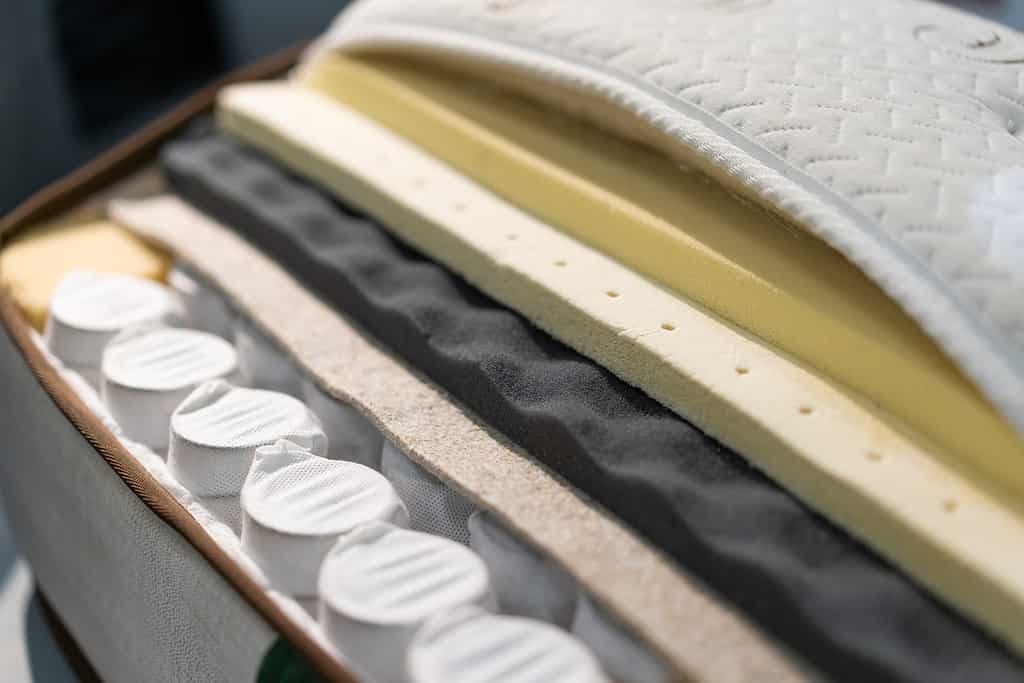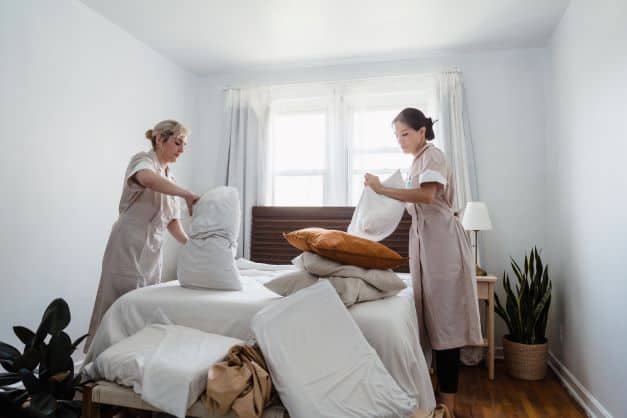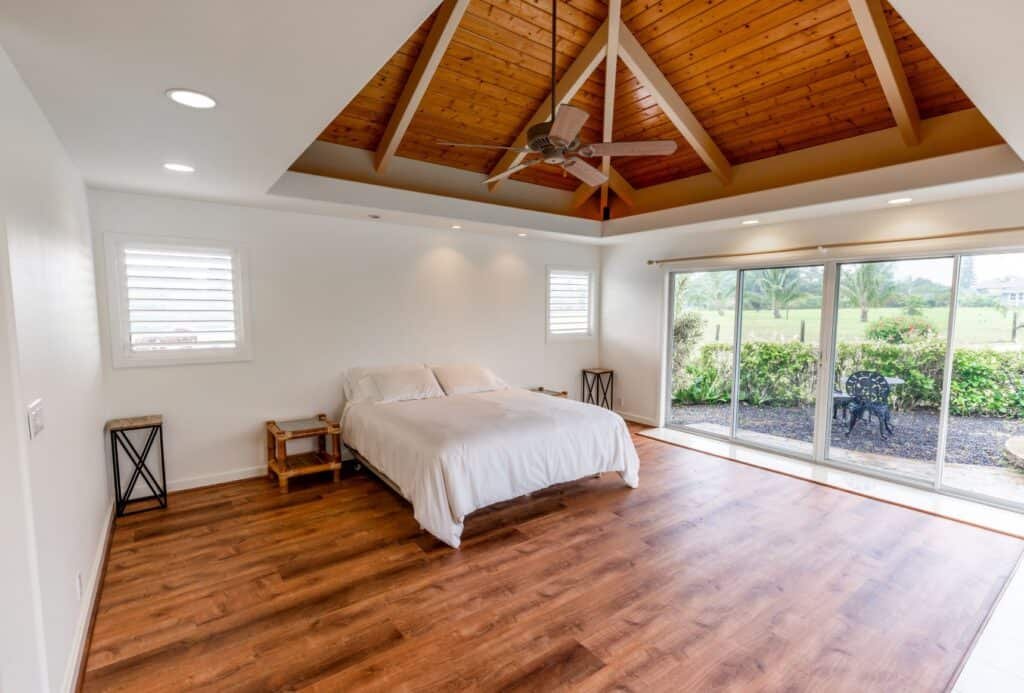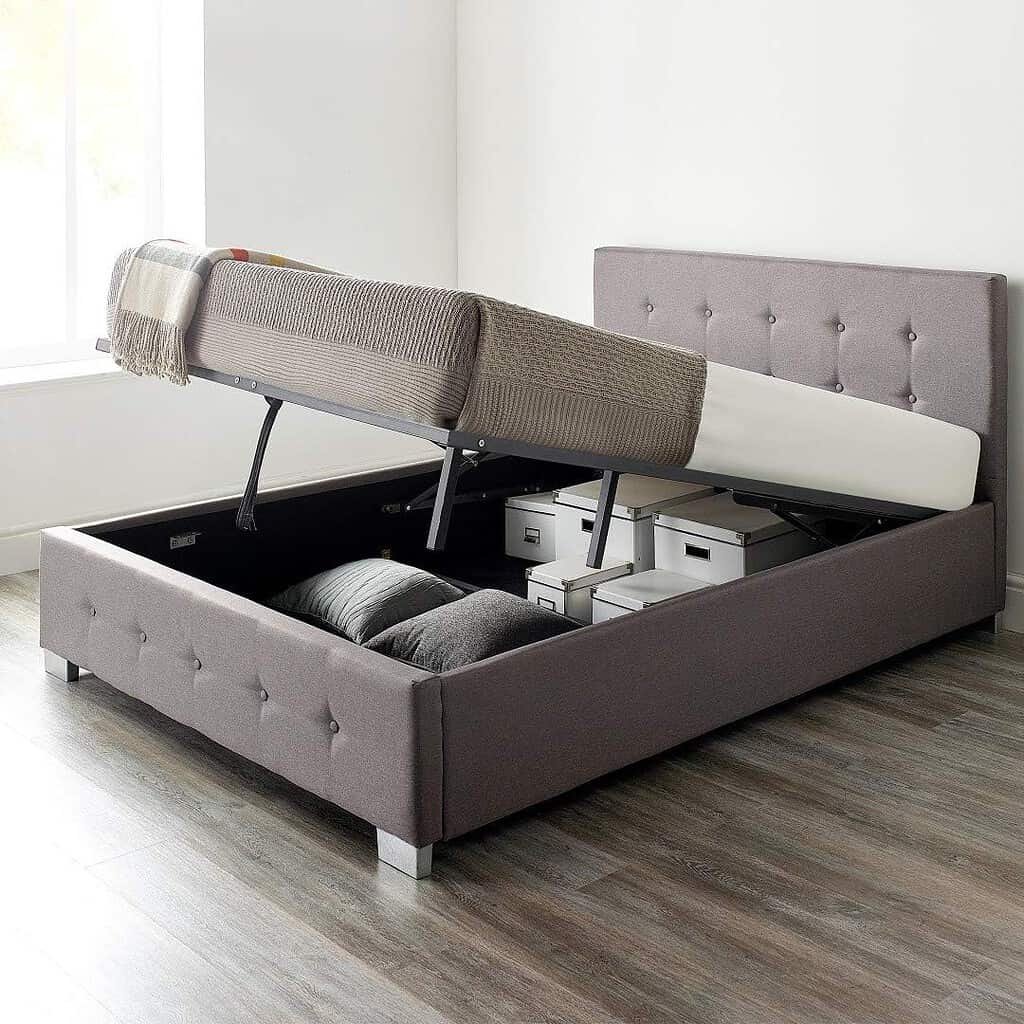Mattress Evolution: Straw to Memory Foam – A Historic Slumber Journey
Understanding Mattresses
Basic Definition
A mattress is a fundamental piece of furniture designed to provide a comfortable sleeping surface. It typically consists of various layers of materials, such as foam, springs, or fibres, encased in a cover. The primary purpose of a mattress is to support the body during sleep, ensuring proper alignment of the spine and relieving pressure points.
The Role of Comfort
Comfort is a critical aspect of any mattress, significantly affecting sleep quality. A comfortable mattress should provide adequate support to the body, ensuring proper alignment and preventing discomfort or pain. Additionally, the materials used in the mattress construction play a significant role in comfort. For instance, memory foam and hybrid mattresses are famous for those seeking support and comfort. Different individuals have varying preferences for mattress firmness levels as well. Some might prefer a firmer mattress for better spinal alignment, while others might opt for a softer mattress to alleviate pressure points. People must choose a mattress that meets their unique comfort needs, which can significantly impact their overall sleep quality.
Origins of the Mattress: Ancient Civilisations
Mattresses in Ancient Egypt
In Ancient Egypt, people valued sleep and rest, creating mattresses to achieve comfort. These mattresses were basic and made from palm leaves, which were collected, piled high and covered with linen to create a soft sleeping surface. The affluent classes would have their beds elevated off the ground using wooden or stone frames, which provided additional comfort and protection from critters.
Mattresses in Rome
In Ancient Rome, mattresses were a sign of wealth and were made to be more indulgent than their Egyptian counterparts. Romans used straw or feathers as stuffing for their mattresses and placed them on elaborate bed frames made from wood, bronze, or even silver. In some cases, more affluent Romans would have mattresses filled with wool or even hair, offering various sleep options to those with the means.
Mattresses in Ancient Greece
The Ancient Greeks also created mattresses for their beds. Although not as luxurious as the Roman version, they used natural materials like wool and animal skins to make soft sleeping surfaces. The Greeks mainly favoured simple wooden bed frames; sometimes, they used ropes or slats to provide additional support for the mattress. Interestingly, the word ‘mattress’ is derived from the Greek word ‘mats,’ which means ‘bed of rushes.’
Other Ancient Civilisations
Outside of Egypt, Rome, and Greece, other ancient civilisations also had their approaches to creating comfortable sleep surfaces. In Asia, the Chinese developed simple yet unique mattresses made of rice straw or silk, while in South Africa, the oldest known bed was discovered, dating back 77,000 years ago. This bedding consisted of layers of plant material gathered into mats, which were periodically burned to eliminate pests. In ancient Mesopotamia, raised beds were prevalent, consisting of mud-brick platforms topped with reed mats or animal furs. Overall, it’s fascinating to see how ancient civilisations laid the foundation for the evolution of mattresses throughout history, shaping how we perceive comfort and establishing the importance of a good night’s rest.
Evolution of Mattresses Through the Middle Ages and Renaissance
Types of Materials Used
During the Middle Ages and Renaissance, mattresses underwent several changes in materials used. In the early medieval period, straw and hay were commonly used as the primary filling materials for mattresses. They were then topped with wool or feathers for added comfort and warmth. Later on, as advancements in textile manufacturing emerged, mattresses became increasingly elaborate, with materials like wool, cotton, and linen playing a more prominent role in their construction[1].
Pillows and blankets also evolved during this time. Wool-based textiles, furs, and intricately embroidered fabrics became popular for pillows and blankets, which helped provide more warmth and comfort [2].
Socioeconomic Differences in Mattresses
Socioeconomic status greatly affected what kind of bed one would sleep on in the Middle Ages and Renaissance; for the less fortunate, beds were made from simple wood frames[3]. These were typically filled with straw or hay for padding and topped with basic fabric coverings. On the other hand, the wealthy slept on extravagant four-poster beds made of luxurious materials like ebony, sometimes even adorned with jewels, gold, and other symbols of high status[4]. Their mattresses were filled with softer, more comfortable substances such as wool or feathers[5].
These differences represented a wealth and social standing divide and impacted the overall sleep quality. The wealthy could afford mattresses that provided better support and insulation, leading to more restful sleep[6]. The Middle Ages and Renaissance saw gradual changes in the materials used for mattresses, pillows, and blankets, as well as a widening divide between the quality of bedding for the rich and those less fortunate. These developments laid the foundation for the more modern sleep surfaces we know today, such as memory foam mattresses.
Footnotes
- From Straw to Memory Foam: A History of Mattresses in the UK ↩
- The History of the Bed, Mattress, and Bedroom – The Spruce ↩
- History of the Mattress (When They Were Invented) | Sleepline ↩
- The History of Mattresses and Beds: A Visual Timeline – Mattress Advisor ↩
- History of Sleep: A Look at the Evolution of Sleep and Beds ↩
- The History of Mattresses and Beds: A Visual Timeline – Mattress Advisor ↩
The Industrial Revolution Impact
Development of Spring Mattresses
During the 19th century, the Industrial Revolution brought significant advancements in the mattress industry. One of the most notable innovations was the introduction of spring mattresses. Springs were first incorporated into bed designs to provide additional support and comfort for sleepers.
The innerspring mattress became popular due to its enhanced support and durability compared to its predecessors, typically made from straw or other materials. This new design featured a core of interlocking steel coils, which conformed to the sleeper’s body shape, providing even weight distribution and pressure relief. These mattresses were initially expensive and considered a luxury item, but the manufacturing process eventually became more efficient, making them more widely available to the general public.
Emergence of the Waterbed
The waterbed, another product of the 19th century, gained popularity alongside the rise of innerspring mattresses. Waterbeds consist of a large water-filled sac encased within a sturdy frame, offering a unique sleeping experience that is both supportive and comfortable.
Waterbeds were initially designed to cater to patients with various health conditions, such as bedsores and spinal problems, as they provided a more body-conforming surface than traditional mattresses. Over time, waterbeds became more widely accepted by the general public for their unparalleled comfort and innovative design. This period of innovation in the mattress industry profoundly influenced how people slept and viewed their resting spaces. The Industrial Revolution laid the foundation for many of the modern mattress technologies we enjoy today, allowing for a more diverse range of options to cater to individual needs and preferences.
The Modern Evolution of Mattresses
Introduction of Memory Foam
In the 20th century, memory foam was developed by NASA scientists to improve the safety and comfort of aircraft seats. This innovative material was designed to mould the body’s shape and return to its original form when not in use. In the 1990s, memory foam entered the mattress industry, offering consumers a new level of comfort and support. Today, memory foam mattresses are popular for their pressure-relieving properties, contouring the body and providing an optimal sleeping surface.
Hybrid Mattresses Advancements
Hybrid mattresses combine the best features of memory foam and innerspring systems, creating a balanced sleeping experience. These mattresses typically feature a support layer of individually pocketed springs, providing optimal weight distribution and responsiveness. Above this support layer, various comfort layers such as memory foam, latex, or gel-infused foam offer contouring and pressure relief. Combining these materials allows hybrid mattresses to adapt to individual sleep preferences, catering to a wide range of sleepers.
The Rise and Fall of Air Mattresses
Air mattresses gained popularity during the late 20th century due to their convenience and portability. Initially designed for camping and temporary use, they quickly gained a reputation for serving as a comfortable alternative to traditional mattresses. However, as technology progressed and the market expanded, air mattresses began to face diminishing popularity. Issues such as punctures, leaks, and reduced support led many consumers to opt for alternative options, such as memory foam or hybrid mattresses. Despite their decline, air mattresses remain suitable for temporary use and outdoor adventures.
The Reinvention of the Waterbed
Waterbeds enjoyed a brief but significant period of popularity during the 1970s and 1980s. Known for their distinctive sensation, these beds contained a water-filled core encased in a padded surface. They offered a unique floating feeling and even claimed to have therapeutic benefits. However, waterbeds’ time in the spotlight was short-lived, and they fell out of favour due to maintenance issues such as leaks, water treatment requirements, and weight concerns. The waterbed has recently grown in popularity with modern designs addressing earlier concerns. These new models showcase more manageable water systems and combine water-based support with memory foam or other comfort layers for an improved sleeping experience.
The Future of Mattresses
As technology continues to evolve, so does the world of mattresses. We can expect to see even more advancements in materials and designs, increasing sleepers’ comfort levels and support. One example is the ongoing development of smart mattresses, which can track sleep patterns and adjust firmness levels accordingly. This technology might offer tailored sleep experiences based on individual preferences and needs as it becomes more advanced.
- Another area of innovation is the sustainable and eco-friendly mattress market. With more people advocating for environmentally friendly practices, the demand for mattresses made with natural, organic, and recyclable materials is on the rise. As new materials and manufacturing processes are discovered, we can anticipate a more comprehensive range of options for eco-conscious consumers, prioritising comfort and environmental responsibility.
- Furthermore, bedding technology advancements can improve sleep quality and overall health. As we continue to learn about the impact of sleep on our physical, mental, and emotional well-being, future mattresses could integrate features to aid in achieving optimal sleep and health. For instance, some mattresses may incorporate temperature control systems, which can adjust the bed’s temperature depending on the user’s preference and current health state.
- It’s also worth noting that the popularity of online mattress shopping has revolutionised the way consumers buy beds, offering more convenience and variety. This trend will likely continue and expand, with mattress companies increasingly using technology to enhance the virtual shopping experience. For example, augmented reality could allow customers to test a mattress in their bedroom virtually, improving the selection process and further streamlining the shopping journey.
The future of mattresses looks bright, with exciting innovations on the horizon that cater to individual needs, comfort preferences, and ecological concerns. It’s fascinating to ponder how the bedding industry will evolve, ensuring restful sleep for future generations while keeping up with the ever-changing world.
Influence of Mattresses on Lifestyle and Culture
Impact on Sleep
Throughout history, mattresses have played a crucial role in improving sleep quality. As mattresses evolved from straw-filled sacks to more comfortable materials like feathers, wool, and eventually memory foam, people experienced better sleep. This, in turn, has positively impacted their overall well-being and productivity.
Modern mattresses made of memory foam, for example, have significantly reduced pressure points and improved spinal alignment. This has enhanced sleep quality and decreased sleep-related ailments such as backaches and insomnia. Sleep has become essential to a healthy lifestyle, and the right mattress ensures good sleep hygiene.
Role of Mattresses in Sex
In addition to sleep, mattresses have played a significant role in sex and intimacy throughout history. As mattresses became more comfortable and supportive, they began influencing couples’ sexual experiences and transforming the bedroom into a private space for intimacy.
With the advancements in mattress technology, couples can now access various mattress types that cater to different preferences and needs. For instance, some couples prefer a bouncier surface for their sexual activities, while others appreciate the motion isolation offered by memory foam mattresses. The historical journey of mattresses – from straw-filled sacks to memory foam – has significantly impacted human lifestyle and culture regarding sleep and intimacy. With continuous innovation in mattress technology, it will be interesting to see how future mattresses further contribute to our well-being and lifestyle experiences.
Global Impact on the Mattress Industry
Mattresses in Japan
The Japanese culture has traditionally preferred minimalist sleeping arrangements, with the futon being a prime example. A futon is a thin, foldable mattress made from cotton or polyester. This simple form of bedding came about to accommodate their small living spaces, but it has had a global influence thanks to its portable nature and ergonomic design. Japan’s Mattresses have slowly evolved to incorporate Western-style features like memory foam, though many still appreciate the traditional futon.
Mattresses in Europe
In Europe, mattresses have come a long way, with various options available to consumers. Historically, straw and natural fibres like wool and cotton were commonly used for bedding; however, with technological advancements, European mattresses began to include features like springs and memory foam. The European mattress industry has played a significant role in shaping mattress technology and design, with potentially ground-breaking contributions to the international market, like the box spring system and the introduction of latex as a mattress material.
Mattresses in USA
The mattress industry in the USA has a rich history and has seen many innovations over the years. Starting with straw and featherbeds, the American mattress industry has evolved to include various innerspring mattresses, memory foam, and hybrid designs. From the widespread adoption of standardised sizes to the cutting-edge innovations of recent years, American mattress manufacturers have consistently worked towards providing comfortable and durable sleeping options for all.
Frequently Asked Questions
What materials were used in ancient beds?
Ancient beds used various natural materials, such as palm leaves, straw, or layers of plants, depending on the region and available resources. For example, the earliest known mattress from around 77,000 years ago was made with alternating layers of reeds and rushes, topped with grasses and leaves for bedding [1].
How has bed design evolved?
Throughout history, bed designs have evolved in response to people’s needs and technological advancements. Bed design has continually improved from simple straw-filled techniques to luxurious featherbeds and horsehair mattresses to the introduction of coil springs in the 19th century. Innovative materials like latex, memory foam, and hybrid combinations have become popular, offering better support, comfort, and breathability[2].
What were the earliest known mattresses?
The earliest-known mattress dates back to around 77,000 years ago, found in a rock shelter in South Africa. This ancient mattress measured approximately three feet by six feet, was less than an inch thick and was made of reeds, rushes, leaves, and grasses[3].
When was memory foam first used in mattresses?
Memory foam was first used in mattresses during the 1990s. Initially developed by NASA in the 1960s for aircraft cushions, memory foam became commercially available in the 1980s. The Tempur-Pedic company popularised memory foam mattresses, leading to the modern-day popularity and wide range of all-foam and hybrid designs[4].
What was the typical mattress like for peasants in medieval times?
In medieval times, peasants would typically sleep on simple straw-filled mattresses. These would be placed directly on the floor or in simple wooden frames, with makeshift bedding materials such as furs or rough cloths for warmth and some degree of comfort[5].
How have mattresses improved through history?
Mattresses have improved throughout history in response to consumers’ evolving needs and desires. They have become increasingly comfortable and supportive of simple straw-filled and plant-based designs, with modern innovations ranging from temperature regulation and zero-gravity support to eco-friendly designs. Hybrid mattresses have also emerged, combining materials like foam, latex, springs, and more to create a tailored sleeping experience[6].
Footnotes
- https://www.tuck.com/mattress-information/history/ ↩
- https://johnryanbydesign.co.uk/understanding-beds/history-of-mattresses-in-the-uk-how-have-mattresses-changed/ ↩
- https://www.tuck.com/mattress-information/history/ ↩
- https://www.mattressadvisor.com/history-of-mattresses/ ↩
- https://morninglife.co.uk/the-history-and-evolution-of-the-mattress/ ↩
- https://www.sleepline.com/history-of-the-mattress/ ↩



